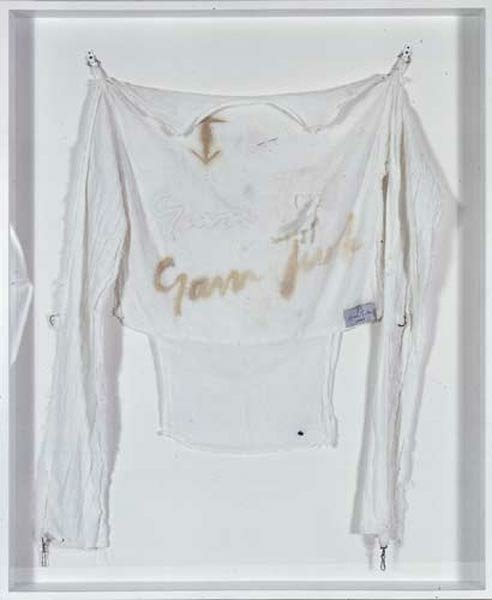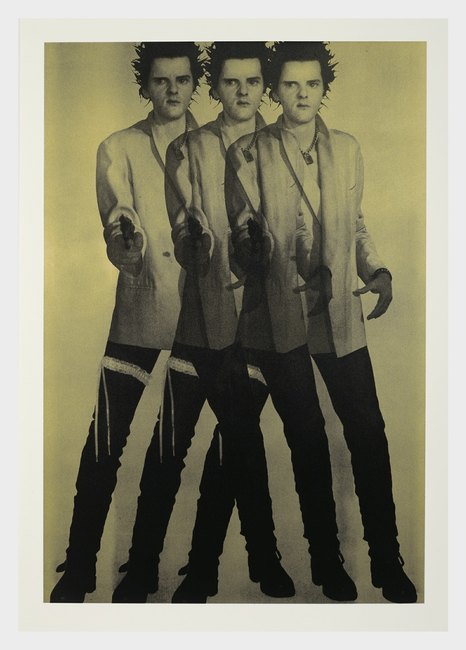AboutEssays1993Punk
In Gavin Turk’s “Pop”, the artist is cast as Sid Vicious via Warhol’s “Elvis”. While Warhol sourced a still from the 1960 film “Flaming Star” for his silk-screened multiples, Turk reproduces Sid’s most iconic moment: the filmed performance of “My Way”, where the junk-sodden singer in a destroyed white dinner jacket shoots the audience in a climactic spasm of disgust.
Both sources are high Pop. Warhol’s images in their various forms: doubled, tripled, colour, black and white are prime exam-ples of Pop Art, while Sid Vicious’ punk de/construction of the narcissistic night-club standard was a Top Ten hit for the Sex Pistols in summer 1978. But they uncover a level of violence and hostility in pop culture that only the bravest seek to explore.
Before the style went national, London Punk was a British version of Andy Warhol’s high Sixties Factory. Many of the musicians and fans were Velvet Underground obsessives who had followed Lou Reed through 1970’s hits like “Walk On The Wild Side” into his later, more self-destructive “Rock’n Roll Animal” incarnation: pure punk with his plastic clothes, dark shades, and A-head jaw-line.
There was the same self-reinvention into cartoon pseudonyms Siouxsie Sue, Soo Catwoman, Johnny Rotten, Sid Vicious only these hard etched characters were not superstars but anti-stars. Early TV footage shows the pure punk gesture: not the rolling back of the eyes or the middle finger, but the look of sheer contempt and disgust with the camera as its subject turns away.
There was the same sense of simultaneity, of young performers immersed in a complete media environment and seeking to turn it to their advantage by being faster and smarter than those who sought to capture their look, their gestures, their souls. ‘You wanna ruin me in the magazine,’ Johnny Rotten sung in his anti-media tract “I Wanna Be Me”; ‘you wanna cover us in margarine’.
Before it was swamped by tabloid front pages and music industry money, Punk sought direct engagement with the death drive implictly contained in the mass media: ‘now is the time to realise,’ Rotten exhorted; ‘to have real eyes’. Hence all the groups with names like the Adverts and Magazine, hence songs like “EMI”, Subway Sect’s “Nobody’s Scared”, and the Slits’ brilliant “FM”.
Both the Factory and early Punk exhibited a blistering, amphetamine derived hostility. Think of Mary Woronov as Hanoi Hannah in “The Chelsea Girls” as she assaults Ingrid Superstar and Pepper with a non-stop: ‘shut up shut up SHUT UP’ or Ondine at the end of the same film, turning on Rona Page with a lightning fast, unstoppable strike of violent vituperation.
Some of this was a pose, derived from hard-faced mentors like Warhol and Malcolm McLaren. Some of it had to do with psy-chological and drug damage. But punk was so littered with nega-tives – nofuturenofeelingsnofun – that its refusals verged on the cosmic. Especially when projected into the wider culture. This was a negation that opposed the easy assumptions of everyday life.
In summer 1977, the BBC shot a special on Punk in Manchester: “Brass Tracks”. Apart from valuable footage of the early Manches-ter scene, the programme is remarkable for the array of adults – preachers, councillors, journalists, almost every kind of adult au-thority figure – condemning these animals. Punk is disgusting, worthless and indicative of a sick society.
The actual punks – Pete Shelley of Buzzcocks, Alan Deaves of the Worst, and Electric Circus amazon Denise – sit quietly while vats of shit are poured over their heads. Then they begin to argue back, quietly and reasonably, and what they say rips their opponents apart: you don’t know what you’re talking about; you’ve been pro-grammed by the media; we’re not the problem, you are.
Behind the blank façade, many early punks were highly idealistic. They believed in what they said, they were in it for the art and the self-expression, they didn’t think about any idea of a career. At its best, particularly in London during 1976 and Manchester the next year, this encouraged an active atmosphere of total communica-tion: if you’ve got something, bring it to the table.
Hence the proliferation of fanzines and punk groups. Participation was the key: ‘I wanna destroy the passerby’. Twenty years into a heavily mediated culture, many Punks instinctively understood what the Situationists, and particular Guy Debord, had defined a decade previously: that the media spectacle fostered passivity and, in fact, worked like a tranquillising drug – soma for the masses.
‘Everybody’s sitting round watching television’, Joe Strummer howled on “London’s Burning”. Many punk songs were deter-minedly in the world. They directly addressed the state of the na-tion, and what they saw was not flattering: a country obsessed by the past, in particular the Second World War, which it had not won but lost – in economic terms at least.
The urban landscape of the late seventies was brutal. In cities like Manchester, Birmingham and London there were vast, empty spaces, often filled with rubble: bomb-sites that had never been built on, slum clearance projects stalled for lack of funds. Much punk iconography focussed on urban dereliction: soulless motor-ways, brick walls, corrugated iron.
Punk had an apocalyptic edge that came from more than am-phetamine. The country had a pre-revolutionary feel, the very strong sense that something was over – the postwar Social contract – and that something new and malign was waiting in the wings. Britain’s fascist party, the National Front, was making electoral gains, while Mrs. Thatcher’s Conservatives prepared for power.
The whole dysfunction between national image and reality was dramatised by the Sex Pistols “God Save The Queen” in June 1977. With almost no support – certainly not from the radical left-wing - the group stood on their hind legs and laid bare the lie behind the pomp: ‘England’s dreaming’. They told a truth that no one wanted to hear, and for their pains were turned into pariahs.
Violence was endemic in Britain at that time. There were major set pieces like the Notting Hill Carnival riot in August 1976 and the Lewisham riot of August 1977 – when anti-fascist protestors tried to stop a National Front march. The Sex Pistols Jubilee boat trip was broken up by the police in a most heavy-handed manner, and then there were the much-publicised tribal Punk-Ted wars.
Creeping surveillance, the breakdown of law and order, the onset of fascism, the atomisation of society: it all seemed like Burroughs’ “The Wild Boys” mixed with Orwell’s “1984” – the year manically apotheosised by the Clash in their song “1977”. And yet, in the blasted inner urban spaces – when not blocked off by serried ranks of police – there was freedom.
Occurring just before the massive regeneration programme that began in the 1980’s, the late seventies were the last time that young people could live cheaply near the city centre: whether in squats or inexpensive flats. All the Sex Pistols squatted at some point or an-other, as did members of the Clash and many other groups. The dereliction fostered the rapid city transits that spawned punk.
The result was a brief, accelerated period when the music and me-dia industries were forced to react to events that they could not control. When the Sex Pistols were vilified by the tabloids after the Bill Grundy show, it radicalised a micro-generation, who could see the difference between reality and its news-managed simulacrum. The adults, in this case, made monster fools of themselves.
Punk’s problems occurred when it achieved the success that it part sought, part shunned. The whole idea of worthlessness encoded in the term made the success difficult to sustain, while the sheer level of exposure to the mass media meant that often sophisticated ideas were flattened out, turned into consumer disposables, and recu-perated. Punk was fast and asymmetric, but it was soon caught.
Sid’s peak performance of “My Way” occurred in spring 1978, right at the moment when Punk negation was turning into self-destruction. It is a complex and problematic clip: Sid is unwell, if not extremely stoned, but he summons up a kind of demonic en-ergy directed at the film-makers, at the audience –whom he shoots in the ultimate act of punk media loathing – and himself.
In this instance, the twinning of Sid with Elvis doesn’t look quite so bizarre. Both were self-made creations from problematic back-grounds who were, at various points, a kind of living litmus test for problems in the wider culture. Both were sent mad by fame and/or notoriety, and both destroyed themselves through heavy use of opiated drugs. Here is the human cost of being an icon.
Thirty years after Sid Vicious’ final overdose, Punk Rock is, like Gavin Turk’s “Pop”, under glass. It is, apparently, in history: its bones endlessly picked over, dismembered and rearranged into lists and rankings, then finally boiled into mushy, nutrition-free gruel – all those sentimental accounts of male bonding. But it has a dark heart and a fearless spirit that is not recuperable.
It was no accident that “Pop” was part of a show – Saatchi’s “Sen-sation” – that attracted exactly the kind of numbskull press atten-tion that punk did in its heyday. Punk laid down a critique and a challenge - as did the hippies before them - that English culture wilfully refused to take up, or even recognise. What is buried and repressed always breaks out with renewed force.
Pop then is a dangerous ideal, particularly if you are trying to summon up the spirits, if not the demons of your time. Warhol suf-fered for telling the truth, as did all of the Sex Pistols – perhaps Sid Vicious the most. People do not want too much cultural reality, but for the true artist – or numinous performer – there is no choice but dive deep into the collective subconscious.



